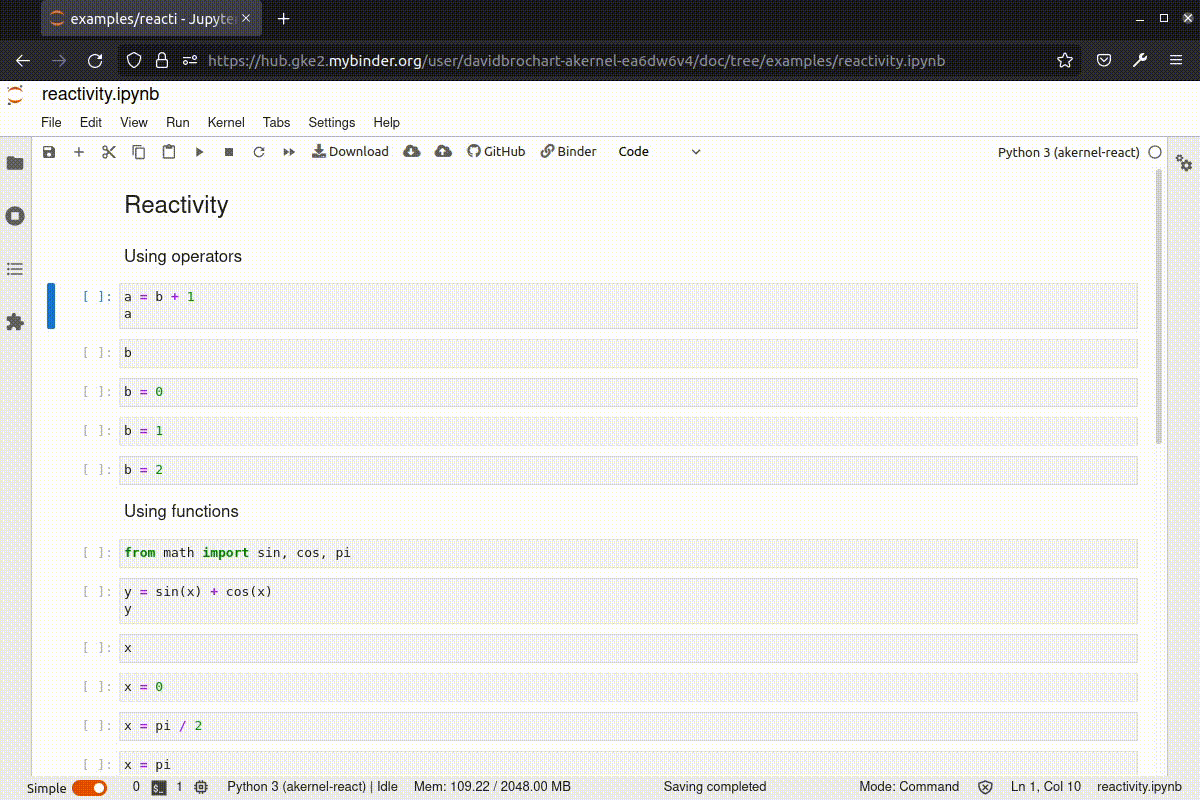An asynchronous Python Jupyter kernel
Project description
akernel
An asynchronous Python Jupyter kernel, with optional reactive programming.
Install
pip install akernel
If you want to be able to use reactive programming:
pip install akernel[react]
Note that it will just add ipyx, which you could also
install later if you want (pip install ipyx).
You can switch between reactive and non-reactive modes by entering (you will need to restart your kernel):
akernel install react # enable reactive mode
akernel install async # disable reactive mode (default)
Motivation
ipykernel offers the ability to
run asynchronous code from the REPL.
This means you can await at the top-level, outside of an async function. Unfortunately, this will still
block the kernel.
akernel changes this behavior by launching each cell in a task.
akernel now also supports reactive programming, although it is still experimental!
Features
Asynchronous execution
akernel allows for asynchronous code execution. What this means is that when used in a Jupyter notebook, you can run cells concurrently if the code is cooperative. For instance, you can run a cell with the following code:
# cell 1
for i in range(10):
print("cell 1:", i)
await asyncio.sleep(1)
Since this cell is async (it has an await), it will not block the execution of other cells.
So you can run another cell concurrently, provided that this cell is also cooperative:
# cell 2
for j in range(10):
print("cell 2:", j)
await asyncio.sleep(1)
If cell 2 was blocking, cell 1 would pause until cell 2 was finished. You can see that by changing
await asyncio.sleep(1) into time.sleep(1) in cell 2.
You can make a cell wait for the previous one to be finished with:
# cell 3
await __task__() # wait for cell 2 to be finished
print("cell 2 has run")
Reactivity
One feature other notebooks offer is the ability to have variables react to other variables' changes. Observable notebooks are a good example of this, and it can give a whole new user experience. For instance, you can run cells out of order:
# cell 1
a = b + 1 # "b" is not defined yet
a
Executing cell 1 won't result in an "undefined variable" error. Instead, the result of the
operation is undefined, and the output of cell 1 is None. You can then continue with the
definition of b:
# cell 2
b = 2 # triggers the computation of "a" in cell 1
Now a, which depends on b, is automatically updated, and the output of cell 1 is 3.
You can of course define much more complex data flows, by defining variables on top of other ones.
Limitations
It is still a work in progress, in particular:
stdout/stderrredirection to the cell output is only supported through theprintfunction.- No rich representation for now, only the standard
__repr__is supported. This means no matplotlib figure yet :-( But since ipywidgets work, why not using ipympl? :-)
Project details
Release history Release notifications | RSS feed
Download files
Download the file for your platform. If you're not sure which to choose, learn more about installing packages.
Source Distribution
Built Distribution
Hashes for akernel-0.0.15-py2.py3-none-any.whl
| Algorithm | Hash digest | |
|---|---|---|
| SHA256 | f651f2c17d2b7c05f1c1aa1f0440fae82151d04c3e9c07c92e531d254d18e77f |
|
| MD5 | d08299bea7784d77387eb4cce3637f52 |
|
| BLAKE2b-256 | c48e7f731b9996019404c69a30632b3a2dd22a4760d696301fba1315630b454b |















